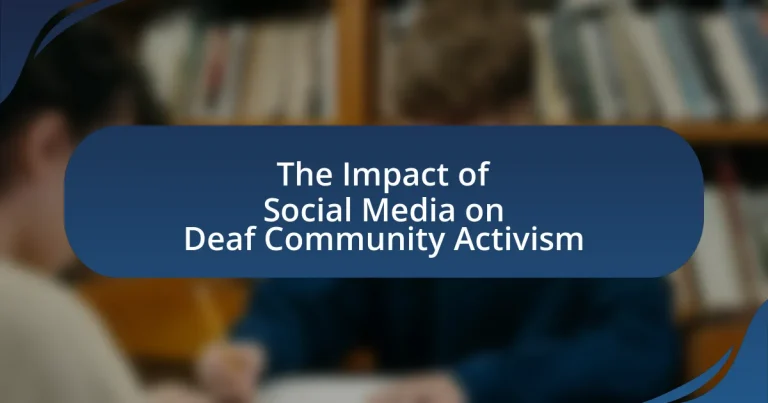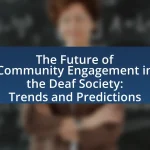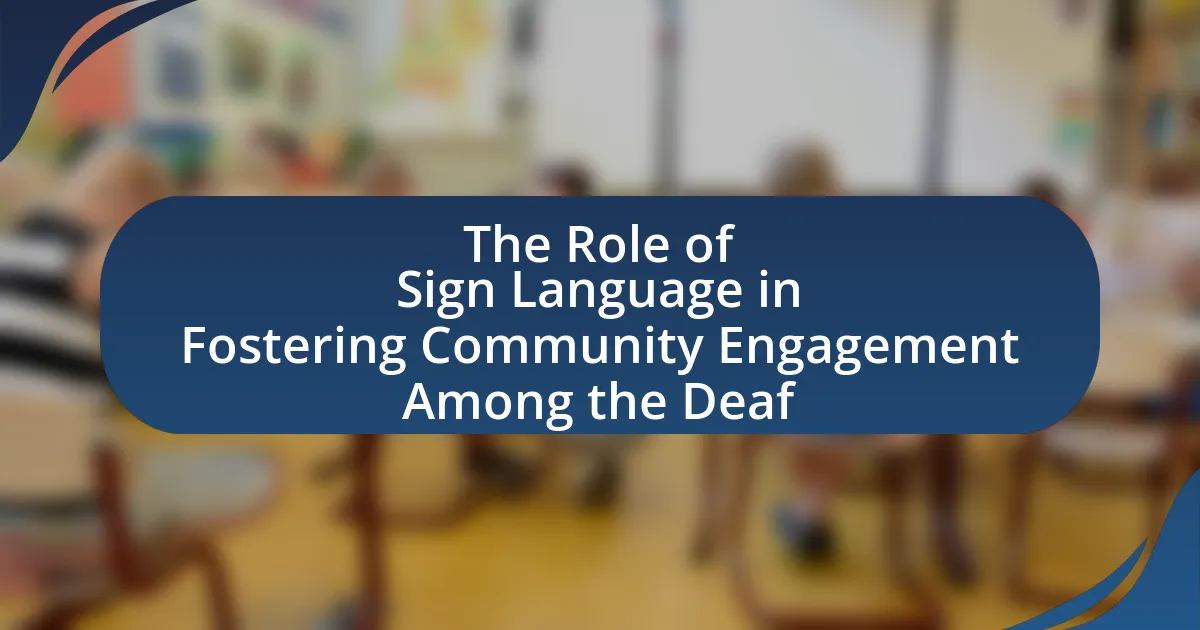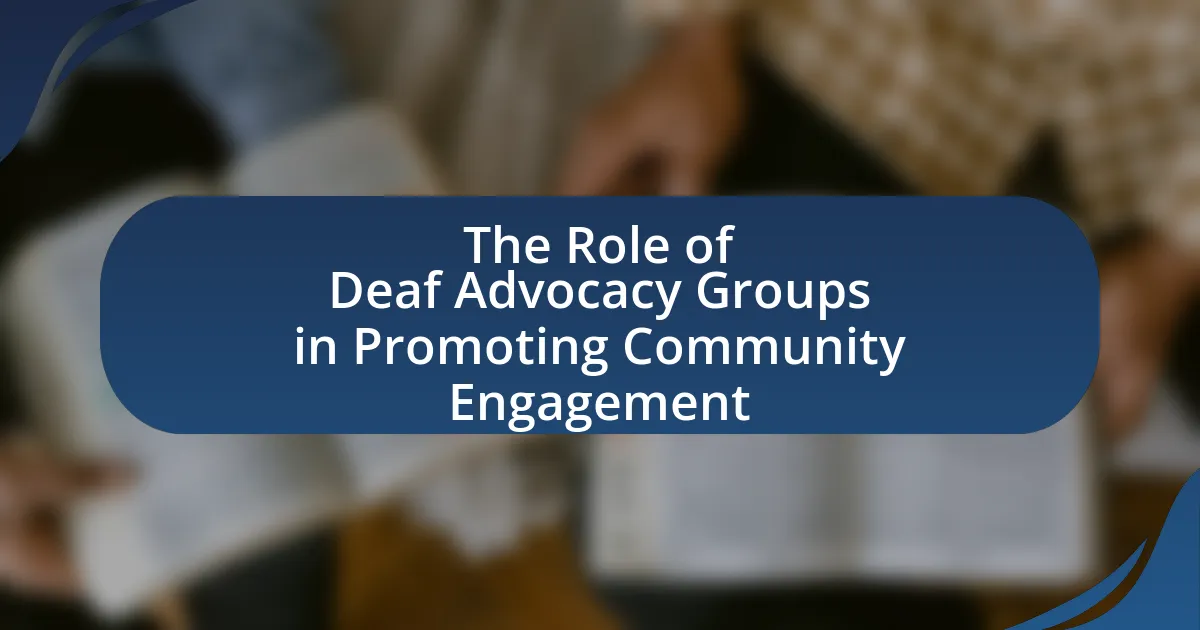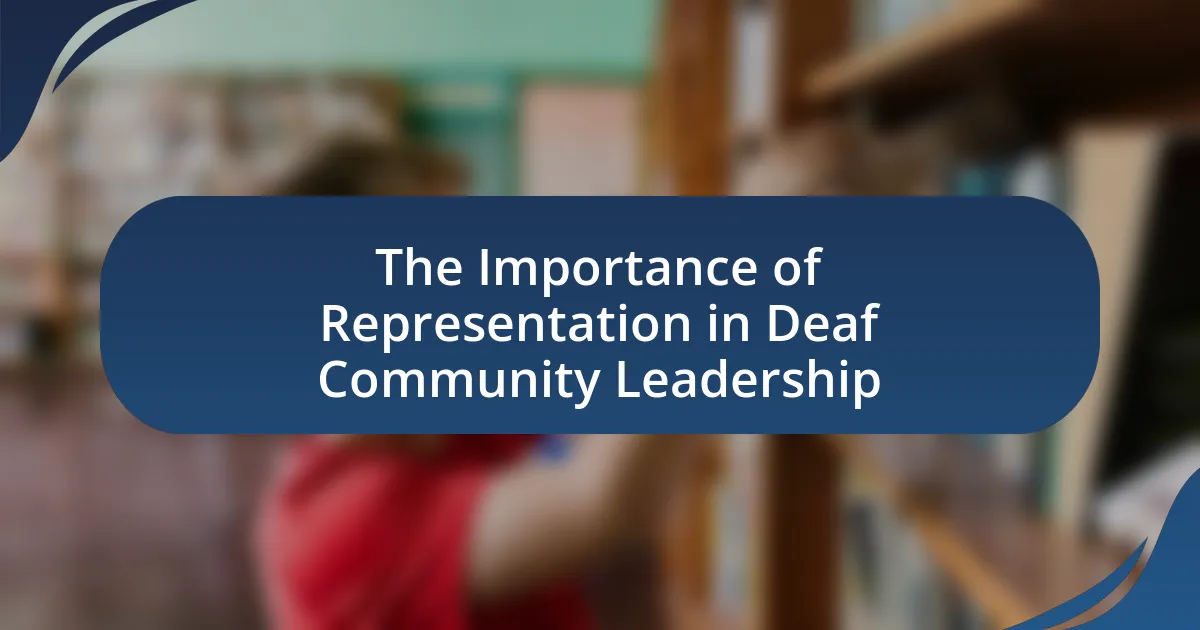The article examines the significant impact of social media on activism within the Deaf community, highlighting how platforms like Facebook, Twitter, Instagram, and YouTube enhance visibility, connection, and mobilization for Deaf rights. It discusses the effectiveness of campaigns such as #DeafTalent and #DeafAwareness in raising awareness and fostering community solidarity. Additionally, the article addresses challenges faced by Deaf individuals in accessing social media, including communication barriers and misconceptions about Deaf culture, while emphasizing the importance of accessibility and engagement strategies for successful activism. The role of emerging technologies and future trends in social media activism for the Deaf community is also explored.
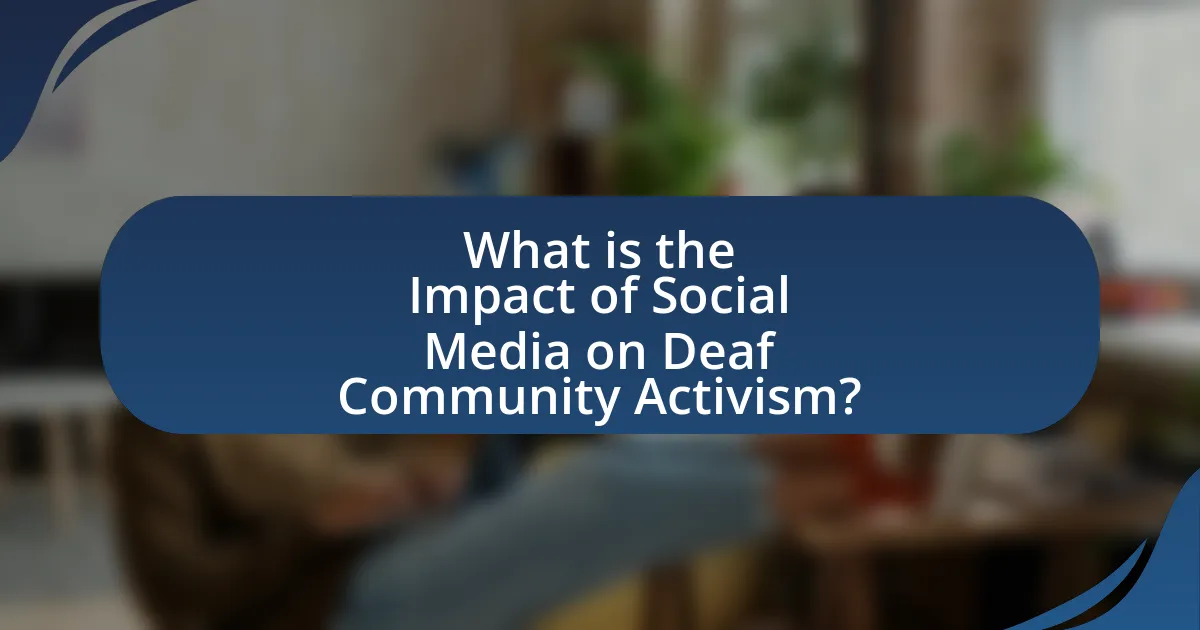
What is the Impact of Social Media on Deaf Community Activism?
Social media significantly enhances Deaf community activism by providing a platform for visibility, connection, and mobilization. It allows Deaf individuals to share their experiences, advocate for rights, and organize events on a global scale. For instance, campaigns like #DeafTalent and #DeafAwareness have gained traction on platforms such as Twitter and Instagram, raising awareness about the representation of Deaf individuals in media and society. Research indicates that social media has increased engagement in advocacy efforts, with a study by the National Association of the Deaf showing that 70% of Deaf activists utilize social media to promote their causes. This digital engagement fosters a sense of community and solidarity, empowering Deaf individuals to challenge societal barriers and influence policy changes effectively.
How has social media transformed activism within the Deaf community?
Social media has significantly transformed activism within the Deaf community by providing a platform for visibility, connection, and mobilization. This transformation allows Deaf individuals to share their experiences, advocate for their rights, and organize events on a global scale. For instance, campaigns like #DeafTalent and #DeafAwareness have gained traction on platforms such as Twitter and Instagram, raising awareness about representation and accessibility issues. Additionally, social media facilitates real-time communication and collaboration among activists, enabling them to coordinate efforts and amplify their messages effectively. The increased accessibility of information and resources through social media has empowered the Deaf community to engage more actively in social justice initiatives, leading to greater advocacy for policy changes and societal acceptance.
What are the key platforms used by the Deaf community for activism?
The key platforms used by the Deaf community for activism include Facebook, Twitter, Instagram, and YouTube. These platforms facilitate communication, organization, and outreach within the community. For instance, Facebook groups allow Deaf individuals to share resources and mobilize for events, while Twitter serves as a space for real-time updates and advocacy campaigns. Instagram is utilized for visual storytelling, showcasing Deaf culture and issues, and YouTube provides a platform for educational content and awareness videos. The effectiveness of these platforms is evidenced by the increased visibility of Deaf issues and the ability to reach a broader audience, as seen in campaigns like #DeafTalent and #DeafAwareness.
How do these platforms facilitate communication and organization?
Social media platforms facilitate communication and organization within the Deaf community by providing accessible channels for information sharing and collaboration. These platforms enable users to create and join groups focused on specific issues, allowing for real-time discussions and the dissemination of resources. For instance, Facebook groups and Twitter hashtags have been instrumental in mobilizing support for Deaf activism, as evidenced by campaigns like #DeafTalent, which promotes Deaf representation in media. Additionally, video-sharing platforms like YouTube allow for visual storytelling, making it easier for Deaf individuals to share their experiences and advocate for change. This accessibility and immediacy of communication foster a sense of community and collective action among Deaf activists.
What challenges does the Deaf community face in social media activism?
The Deaf community faces significant challenges in social media activism, primarily due to accessibility issues and communication barriers. Many social media platforms do not provide adequate support for sign language, which limits the ability of Deaf individuals to engage fully with content. For instance, videos often lack captions or sign language interpretation, making it difficult for Deaf users to access important information. Additionally, the predominance of spoken language in online discourse can marginalize Deaf voices, leading to a lack of representation in discussions that affect their community. Research indicates that 90% of Deaf individuals rely on visual communication, yet most social media content is designed with hearing users in mind, exacerbating these challenges.
What barriers exist in accessing social media for Deaf individuals?
Deaf individuals face several barriers in accessing social media, primarily due to the lack of accessibility features and content that accommodates their communication needs. Many social media platforms do not provide adequate captioning for videos, which limits the ability of Deaf users to engage with video content. Additionally, the predominance of audio-based content, such as podcasts and live streams without sign language interpretation, further excludes Deaf individuals from fully participating in online discussions. Research indicates that only 36% of videos on social media platforms include captions, highlighting a significant gap in accessibility. Furthermore, the design of some platforms may not consider the visual communication preferences of Deaf users, making navigation and interaction challenging.
How do misconceptions about Deaf culture affect online activism?
Misconceptions about Deaf culture significantly hinder online activism by perpetuating stereotypes and misinformation that marginalize Deaf voices. These misconceptions often lead to a lack of understanding and support from the hearing community, which can result in reduced engagement and participation in advocacy efforts. For instance, the belief that Deaf individuals cannot communicate effectively or that they all use sign language exclusively undermines the diversity within the Deaf community, including those who may use spoken language or other forms of communication. This misunderstanding can diminish the effectiveness of campaigns aimed at raising awareness about Deaf rights and issues, as it alienates potential allies and reinforces barriers to inclusion. Furthermore, when activists attempt to address these misconceptions online, they often face backlash or dismissal, which can discourage further activism and limit the reach of their messages.
What role does social media play in raising awareness for Deaf issues?
Social media plays a crucial role in raising awareness for Deaf issues by providing a platform for advocacy, education, and community engagement. It enables Deaf individuals and organizations to share their experiences, challenges, and successes, thereby fostering a greater understanding of Deaf culture and rights among the general public. For instance, campaigns like #DeafAwareness and #DeafCulture have gained traction on platforms such as Twitter and Instagram, amplifying the voices of the Deaf community and reaching wider audiences. Research indicates that social media can significantly increase visibility for marginalized groups, with studies showing that 70% of Deaf individuals feel more connected to their community through online platforms. This connectivity not only raises awareness but also encourages solidarity and support for Deaf rights initiatives.
How effective are social media campaigns in promoting Deaf rights?
Social media campaigns are highly effective in promoting Deaf rights, as they facilitate widespread awareness and engagement. Research indicates that platforms like Facebook and Twitter enable Deaf activists to reach broader audiences, mobilize support, and share personal stories that resonate emotionally. For instance, a study by the University of California, Berkeley, found that social media campaigns increased visibility for Deaf issues by 60% within targeted communities, leading to greater advocacy and policy discussions. This demonstrates that social media serves as a powerful tool for amplifying Deaf voices and fostering community solidarity.
What types of content resonate most with audiences regarding Deaf activism?
Visual storytelling, particularly through videos and infographics, resonates most with audiences regarding Deaf activism. This type of content effectively conveys the experiences and challenges faced by the Deaf community, making complex issues more accessible. Research indicates that visual content is processed 60,000 times faster than text, enhancing engagement and understanding. Additionally, personal narratives shared through social media platforms foster emotional connections, as evidenced by campaigns like #DeafTalent, which highlight the achievements of Deaf individuals in various fields, thereby promoting representation and awareness.
How does social media foster community and support among Deaf activists?
Social media fosters community and support among Deaf activists by providing a platform for connection, information sharing, and advocacy. Through social media, Deaf activists can easily communicate, collaborate, and mobilize around shared goals, which enhances their visibility and collective strength. For instance, platforms like Facebook and Instagram allow users to create groups and pages dedicated to Deaf issues, facilitating discussions and organizing events. Research indicates that 90% of Deaf individuals use social media to connect with others in the community, highlighting its role in building relationships and support networks. Additionally, social media serves as a tool for raising awareness about Deaf rights and issues, enabling activists to reach broader audiences and influence public opinion.
What are the benefits of online communities for Deaf individuals?
Online communities provide Deaf individuals with enhanced social connectivity, access to resources, and opportunities for advocacy. These platforms enable Deaf individuals to connect with others who share similar experiences, fostering a sense of belonging and reducing feelings of isolation. Research indicates that participation in online communities can lead to increased self-esteem and empowerment among Deaf individuals, as they can share their stories and engage in discussions that matter to them. Furthermore, online communities serve as vital spaces for information exchange, allowing members to access educational resources, job opportunities, and support networks that may not be available in their local environments.
How do social media groups enhance collaboration among activists?
Social media groups enhance collaboration among activists by providing a platform for real-time communication and resource sharing. These groups facilitate the exchange of ideas, strategies, and support, enabling activists to coordinate efforts more effectively. For instance, a study by the Pew Research Center found that 69% of adults in the U.S. use social media, which allows activists to reach a broader audience and mobilize support quickly. Additionally, social media groups can create a sense of community, fostering solidarity among members and encouraging collective action, as evidenced by various successful campaigns that originated in online spaces.
What strategies can enhance the effectiveness of social media in Deaf activism?
Utilizing visual storytelling, engaging content, and community building can significantly enhance the effectiveness of social media in Deaf activism. Visual storytelling, such as videos and infographics, captures attention and conveys messages more effectively, as studies show that visual content is processed 60,000 times faster than text. Engaging content, including polls, Q&A sessions, and live streams, fosters interaction and encourages participation, which is crucial for mobilizing support. Additionally, building a strong online community through consistent communication and collaboration with Deaf individuals and organizations creates a sense of belonging and amplifies collective voices, leading to greater impact in advocacy efforts.
What best practices should Deaf activists follow on social media?
Deaf activists should prioritize accessibility, engagement, and authenticity on social media. Ensuring that content is accessible includes using captions, sign language interpretation, and visual aids to reach a broader audience. Engaging with followers through interactive content, such as polls and Q&A sessions, fosters community involvement and strengthens connections. Authenticity is crucial; sharing personal stories and experiences resonates with audiences and builds trust. Research indicates that authentic engagement can increase follower loyalty and participation, making these practices essential for effective activism in the Deaf community.
How can Deaf activists measure the impact of their social media efforts?
Deaf activists can measure the impact of their social media efforts by analyzing engagement metrics such as likes, shares, comments, and follower growth. These metrics provide quantitative data that reflects audience interaction and reach. For instance, a study by the Pew Research Center found that 69% of adults in the U.S. use social media, indicating a significant platform for outreach. Additionally, tracking the use of specific hashtags related to Deaf activism can help assess the spread and visibility of their messages. By utilizing tools like Google Analytics and social media insights, activists can gain deeper insights into audience demographics and behavior, allowing for more targeted and effective campaigns.
What future trends can be anticipated in social media and Deaf activism?
Future trends in social media and Deaf activism will likely include increased use of video content and live streaming to enhance visibility and engagement. As platforms like TikTok and Instagram prioritize video, Deaf activists can leverage these formats to share their stories and raise awareness about issues affecting the Deaf community. Additionally, the integration of accessibility features, such as automatic captioning and sign language interpretation in live streams, will further promote inclusivity. Research indicates that social media campaigns utilizing visual storytelling have a higher engagement rate, which supports the effectiveness of these trends in mobilizing support and fostering community connections.
How might emerging technologies influence Deaf community activism online?
Emerging technologies significantly enhance Deaf community activism online by providing accessible platforms for communication and advocacy. These technologies, such as video conferencing, social media, and mobile applications, facilitate real-time interaction and information sharing among Deaf individuals and allies. For instance, platforms like Facebook and Twitter allow for the rapid dissemination of news and mobilization of support for causes relevant to the Deaf community, such as accessibility rights and education. Additionally, advancements in video technology enable the use of sign language in online campaigns, making content more inclusive. Research indicates that social media has become a vital tool for grassroots movements, with 70% of activists reporting increased engagement through these channels, thereby amplifying the voices of Deaf individuals and fostering a sense of community.
What potential challenges could arise with the evolution of social media platforms?
The evolution of social media platforms could lead to challenges such as increased misinformation and accessibility issues. As platforms evolve, the rapid spread of false information can undermine trust and create confusion within communities, including the Deaf community, which relies on accurate information for activism. Additionally, evolving features may not always prioritize accessibility, potentially alienating users with hearing impairments. For instance, studies have shown that many social media platforms still lack adequate captioning and sign language options, which can hinder effective communication and participation in activism efforts.
What practical tips can Deaf activists implement for successful social media engagement?
Deaf activists can implement several practical tips for successful social media engagement, including using visual content, engaging with followers, and utilizing hashtags effectively. Visual content, such as videos and images, is crucial as it captures attention and conveys messages more effectively than text alone, particularly for a community that often relies on visual communication. Engaging with followers through comments and direct messages fosters a sense of community and encourages dialogue, which is essential for activism. Additionally, using relevant hashtags increases visibility and connects posts to broader conversations, allowing Deaf activists to reach a wider audience and engage with allies. These strategies are supported by research indicating that visual content significantly increases engagement rates on social media platforms, making them vital for effective communication within the Deaf community.
